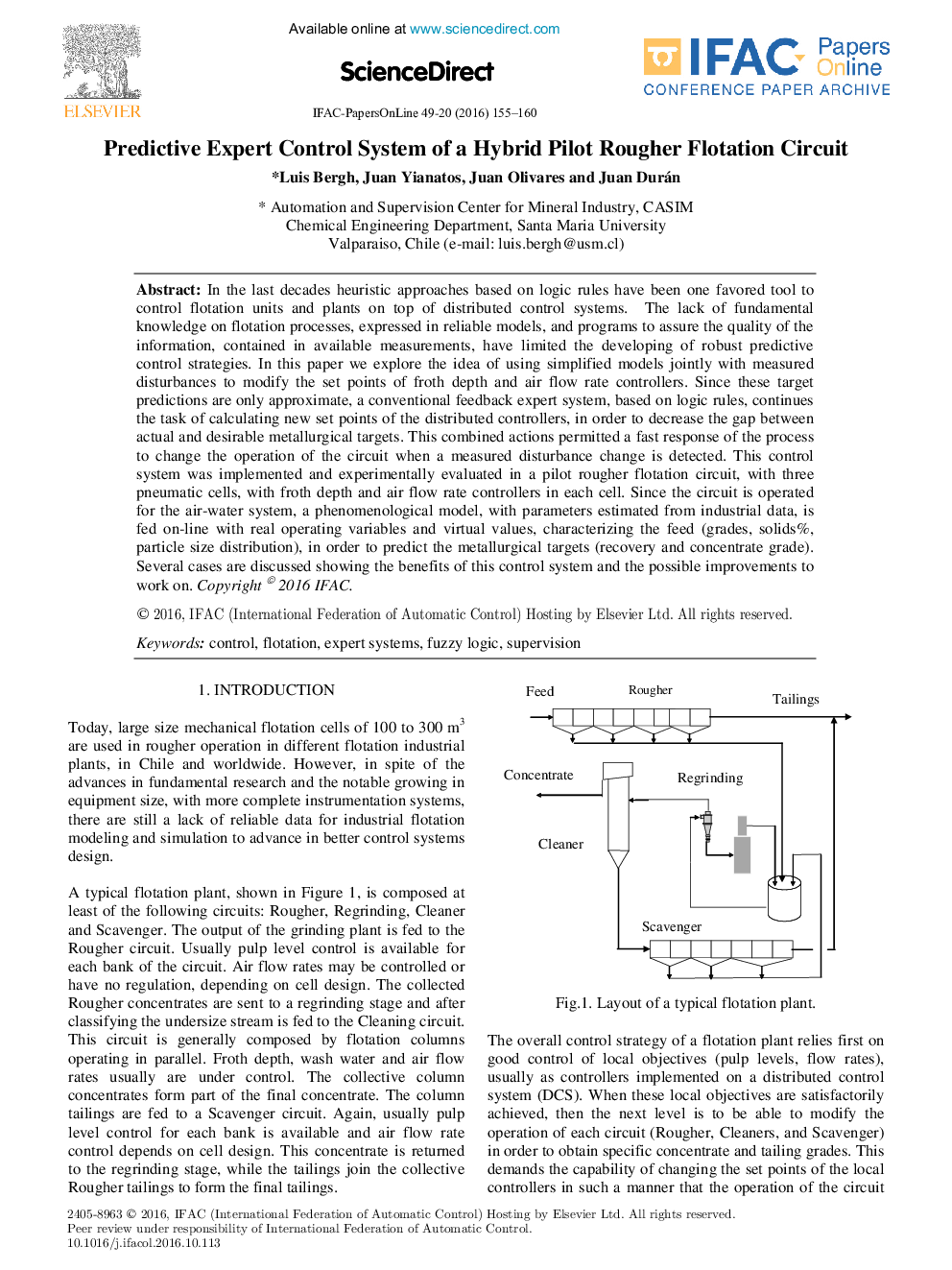| کد مقاله | کد نشریه | سال انتشار | مقاله انگلیسی | نسخه تمام متن |
|---|---|---|---|---|
| 5002999 | 1368461 | 2016 | 6 صفحه PDF | دانلود رایگان |
عنوان انگلیسی مقاله ISI
Predictive Expert Control System of a Hybrid Pilot Rougher Flotation Circuit
ترجمه فارسی عنوان
سیستم کنترل کارشناسان پیش بینی مدار یکپارچه سازی خلبان تیزتر
دانلود مقاله + سفارش ترجمه
دانلود مقاله ISI انگلیسی
رایگان برای ایرانیان
کلمات کلیدی
کنترل، شناور سیستم های خبره، منطق فازی، نظارت،
ترجمه چکیده
در دهه های گذشته رویکردهای اکتشافی بر اساس قوانین منطقی یک ابزار مورد علاقه برای کنترل واحدهای شناور و گیاهان در بالای سیستم های کنترل توزیع شده بوده است. فقدان دانش اساسی در مورد فرایندهای شناور، بیان شده در مدل های قابل اطمینان و برنامه هایی برای اطمینان از کیفیت اطلاعات، که در اندازه گیری های موجود موجود است، توسعه روش های کنترل پیش بینی دقیق را محدود کرده است. در این مقاله، ایده استفاده از مدل های ساده به صورت مشترک با اختلالات اندازه گیری برای تغییر مقادیر مشخص شده ی عمق کف و کنترل کننده جریان هوا بررسی می شود. از آنجاییکه پیش بینی های هدف تنها تقریبی هستند، سیستم متخصص بازخورد متعارف، بر اساس قوانین منطقی، همچنان کار محاسبه نقاط تنظیم جدید کنترل کننده های توزیع را ادامه می دهد تا فاصله بین اهداف واقعی و مطلوب متالورژیکی را کاهش دهد. این اقدامات ترکیبی به پاسخ سریع این فرآیند اجازه می دهد تا تغییر عملکرد مدار هنگامی که یک تغییر اختلال اندازه گیری تشخیص داده می شود. این سیستم کنترل به صورت آزمایشی در یک دریچه فلوتاسیون شبیه ساز، با سه سلول پنوماتیک، با عمق کف و کنترل جریان جریان هوا در هر سلول، مورد آزمایش قرار گرفت. از آنجا که مدار برای سیستم هوا و آب کار می کند، یک مدل پدیدارشناسی با پارامترهای برآورد شده از داده های صنعتی، با متغیرهای عملی واقعی و مقادیر مجازی تغذیه (نمرات، درصد جامدات، توزیع اندازه ذرات)، تغذیه می شود. به منظور پیش بینی اهداف متالورژی (بازیابی و درجه تمرکز). چندین مورد در مورد نشان دادن مزایای این سیستم کنترل و بهبود ممکن است در مورد کار بحث می شود.
موضوعات مرتبط
مهندسی و علوم پایه
سایر رشته های مهندسی
مکانیک محاسباتی
چکیده انگلیسی
In the last decades heuristic approaches based on logic rules have been one favored tool to control flotation units and plants on top of distributed control systems. The lack of fundamental knowledge on flotation processes, expressed in reliable models, and programs to assure the quality of the information, contained in available measurements, have limited the developing of robust predictive control strategies. In this paper we explore the idea of using simplified models jointly with measured disturbances to modify the set points of froth depth and air flow rate controllers. Since these target predictions are only approximate, a conventional feedback expert system, based on logic rules, continues the task of calculating new set points of the distributed controllers, in order to decrease the gap between actual and desirable metallurgical targets. This combined actions permitted a fast response of the process to change the operation of the circuit when a measured disturbance change is detected. This control system was implemented and experimentally evaluated in a pilot rougher flotation circuit, with three pneumatic cells, with froth depth and air flow rate controllers in each cell. Since the circuit is operated for the air-water system, a phenomenological model, with parameters estimated from industrial data, is fed on-line with real operating variables and virtual values, characterizing the feed (grades, solids%, particle size distribution), in order to predict the metallurgical targets (recovery and concentrate grade). Several cases are discussed showing the benefits of this control system and the possible improvements to work on.
ناشر
Database: Elsevier - ScienceDirect (ساینس دایرکت)
Journal: IFAC-PapersOnLine - Volume 49, Issue 20, 2016, Pages 155-160
Journal: IFAC-PapersOnLine - Volume 49, Issue 20, 2016, Pages 155-160
نویسندگان
Luis Bergh, Juan Yianatos, Juan Olivares, Juan Durán,
